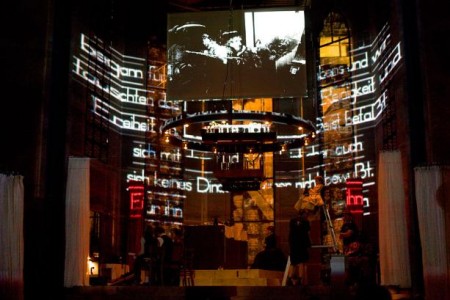„Eine Kirche der Angst vor dem Fremden in mir“ vom 5. bis 8. Juni zu Gast beim 62. Holland Festival in Amsterdam
![]()
Vorstellungen am 5., 6., 7. und 8. Juni 2009, Westergasfabriek Zuiveringshal West, Amsterdam
Weitere Informationen und Tickets unter http://www.hollandfestival.nl
Projektwebseite: www.kirche-der-angst.de

INFORMATION
No other director makes such overt use of politics and social scenarios as Christoph Schlingensief (1960), from his first films in the 1980s through his theatre works in the 90s and public space performances. Eine Kirche der Angst vor dem Fremden in mir (Church of Fear) is a very personal production in which a crucial event in Schlingensief’s life (he was diagnosed with lung cancer in 2008) is the source for a ritual that brings together extreme contradictions. A church will be constructed in the Westergasfabriek’s Zuiveringhal, whereby the performance will take on the character of a Requiem mass. Schlingensief’s body and his ‘life’s art’ needs to be comforted, his demons confronted with rituals taken from the Catholic church and performances by the Fluxus movement.

BACKGROUND INFORMATION
The German film and theatre director Christoph Schlingensief (1960) was diagnosed with a particularly malignant form of lung cancer in January 2008. And he had never smoked. His left lung was removed and he then underwent intensive chemotherapy and radiotherapy. “I felt death, it sat in me. I fought.”
His most important weapon in the fight was his ‚Fluxus-oratorio‘ Eine Kirche der Angst vor dem Fremden in mir, first performed during the Ruhr-Triennale in Duisburg in September 2008. He continually thought about the following phrase during the entire period of his illness: “If your life turns into a tragedy, then try to watch it like a spectator.” He dictated for hours into his tape recorder, this resulting in almost 500 pages of typescript. Short sections of this would finally be used in the production in which his illness played the central role.
It was primarily anger that raged in him during the entire process. “My trust in God and my love for life have both received the deepest of wounds. An unimaginable quantity of filth now streams from my pores, my brain and my nose. But I believe in God; I have always believed in him.” The director renowned as a provocateur, who staged pornographic scenes in the Burgtheater in Vienna, who dragged the gravely-ill onto the stage and who wallowed in decay and putrefaction, nonetheless believes in God. But his anger needed an object.
“My God, why have you abandoned me?” Using Schlingensief’s pre-recorded texts as a point of departure, the central questions of Eine Kirche der Angst are ‘What is my situation with God? How can I make contact with him? Why do I think that I am bad and why do I feel guilty?’ “These thoughts always bring me back to [the German artist] Joseph Beuys, who said ‘It is only when Jesus was abandoned that insight into oneself could begin.’ It is something like that that I am experiencing now.”
Eine Kirche der Angst has a strong resemblance to a Requiem Mass, with the music, images and rituals that are proper to it. The hall is filled with pews, in which the audience take their places. Processions stream through the central aisle to the altar. On the left stands a monstrance in which an X-ray photo of Schlingensief’s impaired lungs is displayed. 8mm films from his childhood are projected onto a white screen. We see scenes from his earlier productions alongside fragments of films from the Fluxus movement — a 1960s movement that attempted to blur the boundaries between the visual arts and music — and the worm-eaten carcass of a hare from his Bayreuth production of Parsifal (2004). Schlingensief and his illness are the central focus, with a homage to Beuys in the motto: “Show me your wounds. He who displays his wounds shall be healed. He who hides them shall not be healed.” He builds himself a church and calls to God from within it. “But the performance is also an act of mercy: a man shares his fear; he makes it as freely available to us as a surplus of heat.” (Die Zeit) We hear the text directly from the tapes that Schlingensief recorded as well as spoken by two actresses underpinned by a child’s voice. There is not only fear, but also anger, although that is possibly the same thing. At the end of the evening the choirs blend together and there even seems to be a possibility of a reconciliation with fate, with the eternal cycle of birth and death.

CREDITS
concept and direction: Christoph Schlingensief
stage design: Thomas Goerge
stage design: Thekla von Mülheim
costume design: Aino Laberenz
lighting design: Voxi Bärenklau
editing film, video: Heta Multanen
sound design: David Gierth
dramaturgy: Carl Hegemann
cast: Margit Carstensen, Irm Hermann, Mira Partecke, Komi Mizrajim Togbonou, Stefan Kolosko, Karin Witt, Horst Gelonnek, Kerstin Grassmann, Norbert Müller, Achim von Paczensky, Klaus Beyer
singer: Friederike Harmsen, Ulrike Eidinger
composition / percussion: Michael Wertmüller
repititeur / organ player: Dominik Blum
project management: Ulli Stepan
choir: Gospelchor Angels Voices
production: RuhrTriennale